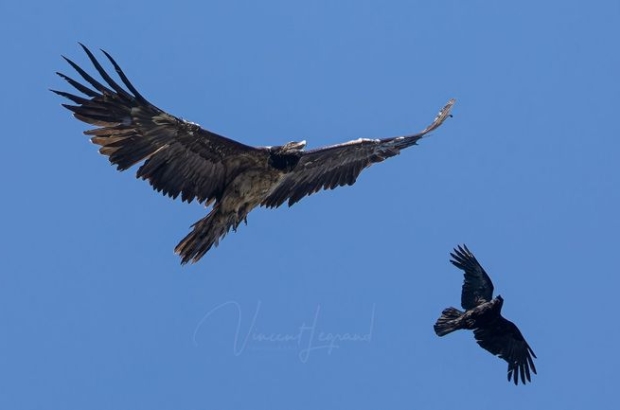- Daily & Weekly newsletters
- Buy & download The Bulletin
- Comment on our articles
Large bird of prey spotted in Brussels
A bearded vulture was spotted over Brussels recently – an unusual sight considering the massive bird of prey is normally spotted in the Alps and other mountains of southern Europe.
The scavenger bird can reach a wingspan of three metres, RTBF reports, and some worry that its presence as far north as Brussels is a result of climate change.
The bird was photographed on Saturday 10 June on the banks of the canal between Forest and Anderlecht by Vincent Legrand, a wildlife photographer.
“It was a young naturalist, Diego, who spotted the specimen while walking along the canal on Friday evening,” Legrand told RTBF. Diego used his binoculars to identify the bird as a lammergeier, a large vulture-like bird of prey, but was without a camera.
“I went to the site on Saturday morning and soon enough I saw a commotion among the crows – it's not unusual to see them attacking large birds of prey – and the lammergeier was indeed there, but by the time I had circled it a few times, it had disappeared,” Legrand said.
“Fortunately I was able to take a few photos. It's not the first time I've seen one but it's impressive all the same, especially as it's a typical mountain bird.”
Didier Vangeluwe, ornithologist at the Museum of Natural Sciences, explained that the bearded vulture is rarer than other types of birds in the same family.
“The bearded vulture is super-rare because it is a bird with a very particular ecology,” Vangeluwe said.
“While vultures feed on the remains of animals, the bearded vulture goes after them when all that's left is the carcass. It picks up the bones, flies off and drops them on rocks so that they shatter and it can then come and suck out the marrow.
"It's quite an unheard-of process. With its three-metre wingspan, it could pick off prey, but no, it preys on bones. Though obviously, if it comes across a nice piece of meat, it's not going to miss out.”
Vangeluwe cautioned against being too quick to blame climate change for the bird’s presence in the Belgian capital.
“There have always been a few of these birds of prey, but the reintroduction programmes that began in the Alps in the mid-1980s are bearing fruit and today we're seeing more of them,” Vangeluwe said.
“There are 250 breeding pairs in the whole of Europe. So it's their protection that explains their greater presence. And as they have a long period of immaturity, meaning that it takes a long time for young birds to become adults and settle down somewhere, they travel all over Europe.”
That being said, climate change has played a role: the birds are being driven to increasingly northern locations as a result of heatwaves.
“These big birds are like sailboats, like gliders, they can only travel long distances if there are warm winds that carry them over long distances without expending too much energy – thermals as we call them,” said Vangeluwe.
“So obviously, they only do it at this time of year, and they do it all the earlier because the weather is warmer. We're seeing more and more birds from the south migrating north, and we've even spotted some in Sweden – it's mind-boggling. It's like the seals on our beaches or the walruses in the Netherlands.”
But the bearded vulture in Brussels was especially peculiar: “It didn't look ringed and its feathers hadn't been coloured either, as is the case when you ring a young bird from a reintroduction colony, so it's a wild individual, and that's even rarer.”
Birds of prey are being spotted more often in Belgium, including a recent sighting of around 20 griffon vultures in Flanders.
Flemish environmental organisation Natuurpunt spoke of a tsunami of southern birds, though Vangeluwe called this an exaggeration.
“We see griffon vultures here every year – they come by the dozens, even hundreds in the spring, and they always arrive at the same time, at the end of May, beginning of June,” Vangeluwe said.
“This has been the case since 2001, whereas between 1900 and 2000 there were just five sightings. Why are there so many vultures in our national skies? Quite simply because the species had been extinct in France since 1930 and there have been very intensive reintroduction programmes in the Gironde, Tarn and Alps, among other places, and there are now thousands of individuals.”
The vultures visiting Belgium are not dangerous and not likely to stay in the country. Natuurpunt said that if the birds cannot find enough food and a place to breed in Belgium, they will probably head back south soon.
Photo: Vincent Legrand


















